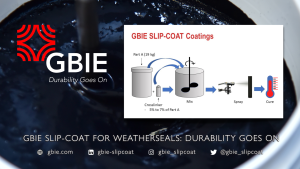
GBIE SLIP-COAT coatings for automotive weatherstrips are known for their durability and superior adhesion to the substrate but how can we consistently achieve these qualities when there is such a wide range of different elastomer-based compounds used in weatherseal applications? EPDM or TPE is not a single uniform material, there are thousands of compounds of each that GBIE SLIP-COAT coatings must adhere to. So how do we do it?
It’s all about continuous innovation for over three decades. We start with one of multiple water-based PU dispersions that we use and, in our R&D lab, our material scientists can adjust the formulation by using different particles (materials, sizes, and morphologies), various lubricating agents, adhesion promoters, surfactants, and defoamers. When you consider that each of these broad categories will have dozens to hundreds of unique possibilities to try, you will begin to understand the complexity of formulating coatings. This is why having more than three decades of development experience is so important. There’s so much that goes into coatings to reach the level of performance that GBIE has built its reputation on!
But the prior paragraph only describes the Part A component of our two-component coating system. Now, we must mate the Part A to one of many dozens of available crosslinkers. Different EPDMs and TPEs require different combinations of Part A and crosslinker and with 20-plus Part A coatings and six different crosslinkers, we’re more than likely to be able to develop the optimal coating solution for any substrate, but if we need to, our R&D lab will always create a new coating at no cost to the customer.
We also help our customers in optimizing production conditions to get the optimal application of SLIP-COAT so it will remain on the weatherseal for the lifetime of the vehicle but more about this in another post!
If you have any questions on our SLIP-COAT products’ durability and adhesion just get in touch!
slip-coat@gbie.com
Please follow us on our LinkedIn page »